SDTEST® has 38 different VUCA polls that calculate the 13,643 correlation values between stages of development according to the theory of Spiral Dynamics and answer options of these 38 polls.
We invite curiosity about the systemic mechanisms behind this correlation. There may be hidden variables that provide alternative explanations.
In our analysis of the poll "Reasons why people give up" (by Anna Vital [1]), we found an intriguing positive linear/ correlation that warrants closer examination:
0.0680 (Pearson) between the Overwork and the Purple stage.
The critical value of the correlation coefficient for a normal distribution, by William Sealy Gosset (Student), is r = 0.0518. Nevertheless, this positive linear correlation of 0.0680 meets the reliability criteria but does not necessarily imply causation.
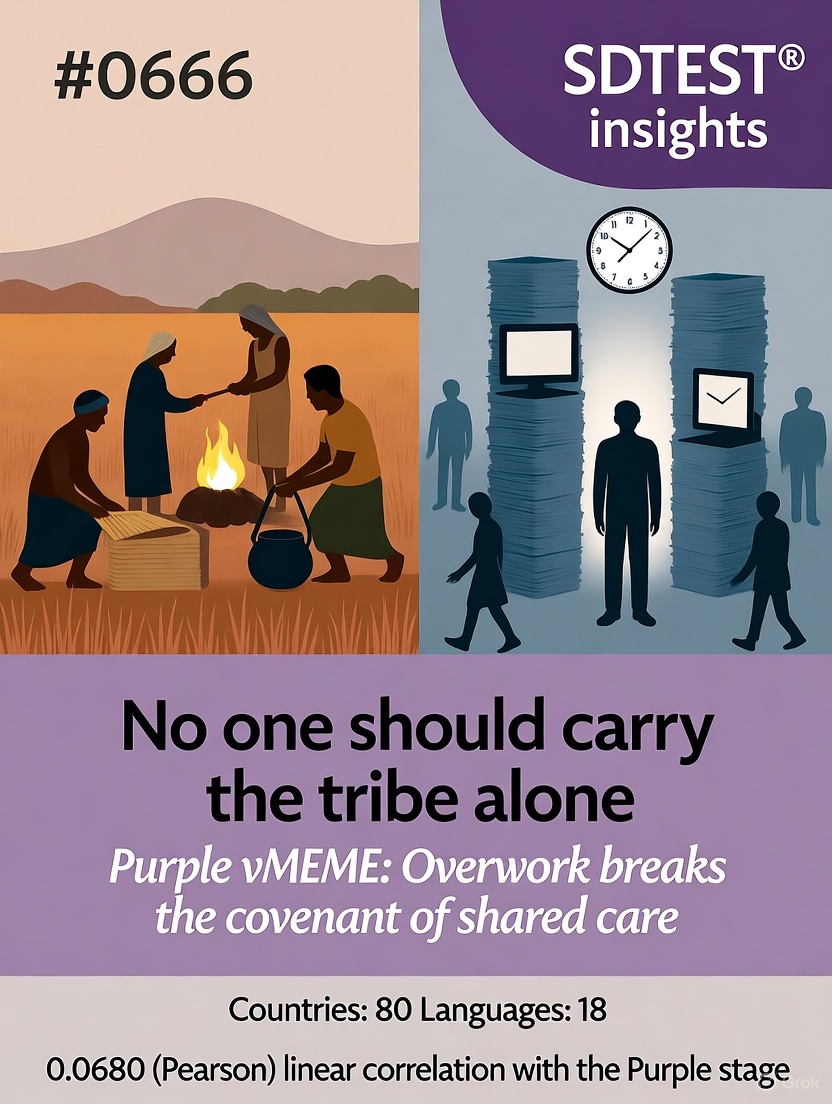
This positive correlation of 0.0680 between Overwork and the Purple stage offers intriguing insights when viewed through the lens of the Purple value system:
Organizational Perspective:
Organizations operating within the Purple mindset might interpret this correlation as:
- A sign that the spirits or ancestors are displeased when the natural rhythm of work-rest is violated.
- Confirmation that communal labor must follow the sacred seasonal cycle, not the endless demands of outsiders.
- Evidence that overwork breaks the taboo of balance ordained by the forefathers and the earth.
These organizations might respond by:
- Restoring traditional feast and rest days dictated by lunar or harvest calendars.
- Consulting the elder or shaman to perform rituals that re-harmonize workers with tribal work taboos.
- Re-assigning tasks along kinship lines so no clan is overburdened and angered ancestors.
Team Perspective:
Teams operating from a Purple mindset might approach this correlation by:
- Viewing it as an omen that the group-work chant has been forgotten or shortened.
- Interpreting it as punishment for neglecting the shared meal and dance that renew collective strength.
- Seeing it as validation that the tribe’s spirit-protector retreats when members are pushed beyond the ancestral limit.
These teams might respond by:
- Re-instituting the circle-blessing before and after any joint labor.
- Rotating duties so every member can keep the taboo of nightly storytelling and dream-sharing.
- Offering the first fruits of labor to the totem to ask forgiveness for past overwork.
Individual Perspective:
Individuals aligned with the Purple value system might interpret this correlation as:
- Personal warning that they have strayed from the path walked by their grandparents.
- Evidence that their own spirit-guardian grows weak when daylight hours are filled only with toil.
- Confirmation that identity is rooted in the tribe’s rhythm, not in the outsider’s clock.
These individuals might respond by:
- Seeking the elder’s dream-reading to discover which ritual was skipped.
- Wearing the clan amulet only during prescribed hours to avoid drawing exhaustion-spirits.
- Re-joining communal singing at dusk to re-align heartbeat with the group’s sacred pulse.
This correlation, viewed through the Purple lens, suggests that those operating at the Purple level may be more likely to cite overwork as a reason for quitting because it violates the timeless covenant between the living, the ancestors, and the earth.
The reasons why Overwork might not be seen as an acceptable part of life in the Purple stage could include:
- Ancestral Taboo: Continuous labor without the prescribed rest offends the spirits who handed down the work-rest cycle.
- Communal Balance: Overwork in one kin-group threatens the spiritual equilibrium protecting the entire village.
- Ritual Disruption: Extended labor interrupts the rites that renew the tribe’s collective soul and ensure rain, fertility, and game.
- Identity Through Belonging: Personal worth is measured by participation in shared ceremonies, impossible when one is perpetually working.
- Sacred Seasonality: The gods and ancestors have set times for planting, harvesting, dancing, and storytelling; overwork ignores these divine rhythms.
This correlation prompts us to consider how different value systems influence perceptions of healthy effort within communities. It raises questions about the potential benefits and drawbacks of a Purple approach to work-life balance, particularly in contexts where long-term communal survival and spiritual harmony are crucial.
Ultimately, this correlation highlights the complex interplay between cultural values, communal dynamics, and organizational effectiveness. Overwork might be seen not merely as fatigue but as a spiritual breach whose repair requires ritual, elder wisdom, and reunion with the tribe’s ancestral heartbeat in Purple-dominant environments.
In our analysis of the poll "Real freedom is," we found an intriguing positive linear correlation that warrants closer examination:
0.1978 (Pearson) between the Living without rules or obligations / Agree strongly and the Red stage.
The critical value of the correlation coefficient for a non-normal distribution, by Spearman, is r = 0.0033. Nevertheless, this positive (linear/nonlinear) correlation of 0.1632 meets the reliability criteria but does not necessarily imply causation.
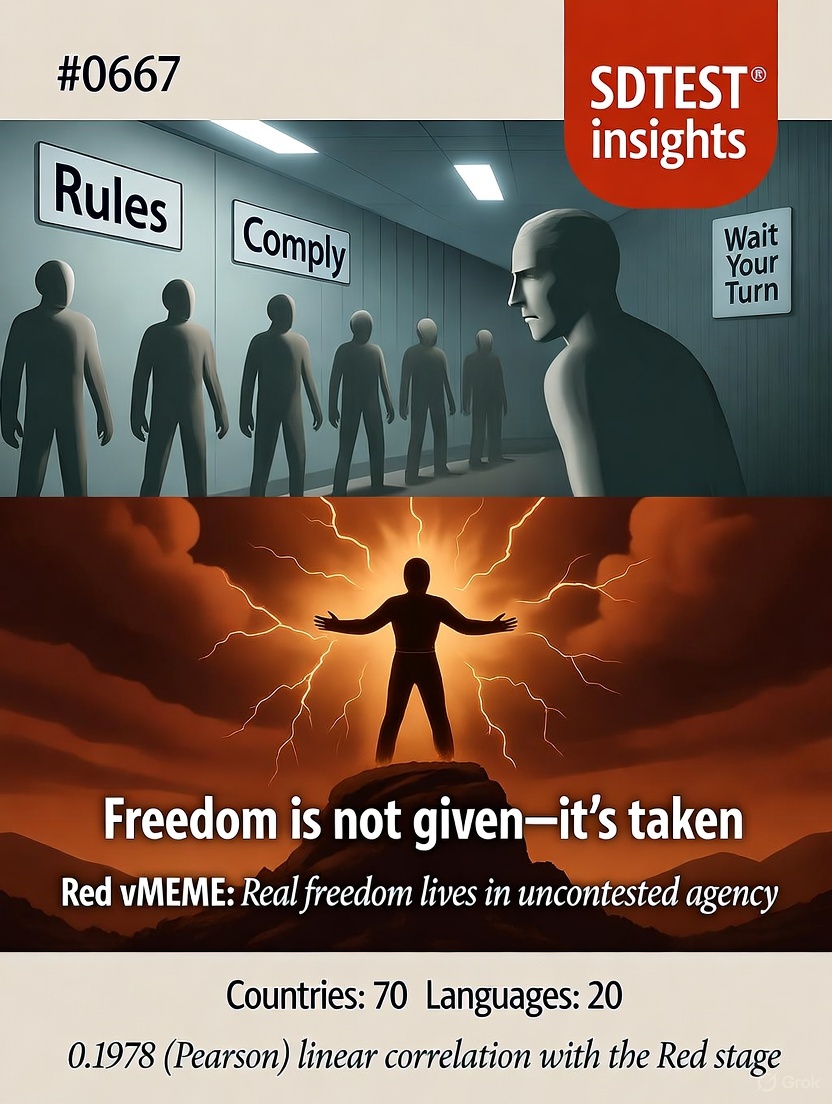
This positive correlation of 0.1978 between “Living without rules or obligations / Agree strongly” and the Red stage offers intriguing insights when viewed through the lens of the Red value system:
Organizational Perspective:
Organizations operating within the Red mindset might interpret this correlation as:
- Validation of their warrior-culture conviction that imposed rules weaken raw power and slow immediate victory.
- Confirmation that hierarchy should be maintained by force, not by policy manuals or compliance departments.
- Evidence supporting their belief that true dominance emerges when the strongest are free to act on impulse without bureaucratic chains.
These organizations might respond by:
- Tearing up procedure handbooks and letting department chiefs impose will through sheer authority and personal clout.
- Installing “power contests” where the winner rewrites the rules on the spot.
- Rewarding managers who achieve quarterly targets by ignoring regulations and crushing opposition.
Team Perspective:
Teams operating from a Red mindset might approach this correlation by:
- Viewing it as proof that ritual obedience to protocols saps the aggressive spirit needed to win.
- Interpreting it as support for the creed “only the unbound strike fastest.”
- Seeing it as validation that every team member should seize opportunities the moment desire flares, not wait for permission.
These teams might respond by:
- Cancelling standing meetings; whoever shouts loudest sets the day’s tactics.
- Encouraging members to raid resources from other teams and boast about the haul.
- Celebrating sudden, rule-breaking pivots that bring immediate spoils.
Individual Perspective:
Individuals aligned with the Red value system might interpret this correlation as:
- Personal proof that shackling oneself to obligations insults their inner war-spirit.
- Evidence that the universe rewards those who grab what they want the instant craving hits.
- Confirmation that contracts, timetables, and social expectations are traps set by the weak to cage the strong.
These individuals might respond by:
- Quitting jobs the moment a supervisor utters the word “policy.”
- Viewing contracts as mere suggestions to be broken when a better thrill appears.
- Using the correlation as ammunition to intimidate rule-enforcers: “Science says I’m right—step aside.”
This correlation, viewed through the Red lens, suggests that those operating at the Red level equate freedom with the absence of external restraints. It implies that the Red value system’s impulsiveness, dominance, and hunger for immediate gratification align with a declaration that obligations are enemies to be destroyed.
The reasons why “Living without rules or obligations” might not be seen as reckless but as essential in the Red stage could include:
- Power Unleashed: Rules are perceived as cages that muffle the raw force Red relies on to prevail.
- Immediate Gratification: Delay imposed by obligation contradicts the Red demand to seize pleasure now.
- Self-Definition: Identity is forged through triumphant acts of defiance, not through conforming edicts.
- Competitive Edge: The less one is bound, the faster one can strike before rivals react.
- Mythic Heroism: Red mythology glorifies the lone warrior who bends no knee to external command.
This correlation prompts us to consider how different value systems influence perceptions of liberty and constraint. It raises questions about the potential benefits and drawbacks of a Red approach to social order, particularly in contexts where long-term collaboration and complex problem-solving are crucial.
Ultimately, this correlation highlights the complex interplay between cultural values, personal dominance, and organizational effectiveness. Rejection of rules might be seen not as chaos but as the natural and even desirable state of interaction in Red-dominant environments.
In our analysis of the poll "What makes a boss a great leader?", we found an intriguing negative linear correlation that warrants closer examination:
-0.0448 (Pearson) between the Empathy and the Blue stage.
The critical value of the correlation coefficient for a normal distribution, by William Sealy Gosset (Student), is r = 0.0385. Nevertheless, this negative linear correlation of -0.0448 meets the reliability criteria but does not necessarily imply causation.
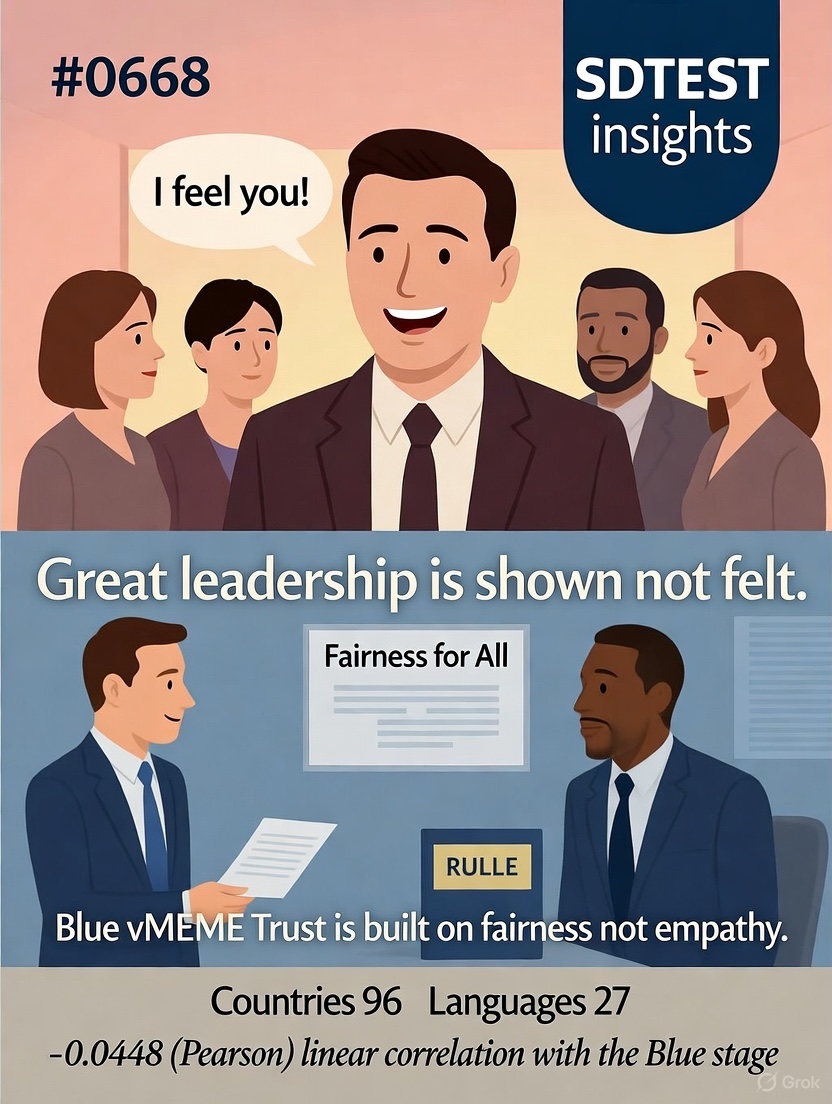
This negative correlation of –0.0448 between “Empathy” as a leadership ideal and the Blue stage offers intriguing insights when viewed through the lens of the Blue value system:
Organizational Perspective:
Organizations operating within the Blue mindset might interpret this correlation as:
- Validation that dispassionate enforcement of rules, not emotional warmth, preserves the sacred order handed down from authority.
- Confirmation that hierarchical discipline is weakened when leaders become “soft” or personally relatable.
- Evidence supporting their belief that universal duty outweighs individual feelings, ensuring uniform compliance across ranks.
These organizations might respond by:
- Rewriting leadership competency lists to prioritize “fair application of code” over “understands personal struggles.”
- Promoting managers who deliver consistent rulings, citing policy verse-and-chapter rather than listening to emotional appeals.
- Installing review boards that reward adherence metrics and flag empathic “exceptions” as non-conforming.
Team Perspective:
Teams operating from a Blue mindset might approach this correlation by:
- Viewing it as affirmation that rules, not relationships, keep the unit mission-ready and morally upright.
- Interpreting it as proof that empathic leaders risk showing favoritism, corroding the equalizing force of standardized procedures.
- Seeing it as validation that discipline and predictable consequences—not emotional support—secure loyalty to the chain-of-command.
These teams might respond by:
- Beginning meetings with a recitation of governing principles instead of “check-ins” on personal well-being.
- Encouraging members to report peers who bypass protocol for empathic reasons, framing it as protecting collective integrity.
- Celebrating leaders who apply the same penalty or reward regardless of individual hardship stories.
Individual Perspective:
Individuals aligned with the Blue value system might interpret this correlation as:
- Personal proof that empathy clouds the clear right/wrong lens granted by a higher authority.
- Evidence that a truly righteous leader enforces the code impartially, reserving warmth for private prayer, not public policy.
- Confirmation that emotional leniency undermines the moral backbone required to hold the line against wrongdoers.
These individuals might respond by:
- Consciously suppressing sympathetic impulses when issuing directives, citing “duty over inclination.”
- Viewing empathic bosses as well-meaning but weak, potentially endangering the group’s moral certification.
- Using the correlation as scriptural support: “Even the data show sentiment must bow to statute.”
This correlation, viewed through the Blue lens, suggests that those operating at the Blue level may withhold empathy from the leadership ideal, equating impartial rule-application with higher righteousness.
The reasons why Empathy might not be seen as essential for a great leader in the Blue stage could include:
- Rule Supremacy: Objective codes are considered divinely or institutionally ordained; subjective feeling risks adulterating them.
- Uniform Justice: Empathy introduces variability, threatening the equal treatment that validates the group’s moral authority.
- Chain-of-Command Clarity: Detached decisions reinforce position boundaries, preventing emotional confusion about who decides.
- Moral Purity: Showing “too much understanding” can appear to excuse sin, diluting the stark right/wrong worldview.
- Disciplinary Predictability: Members comply best when consequences are foreseeable; empathy is feared as a wildcard that softens expected penalties.
This correlation prompts us to consider how different value systems influence perceptions of healthy leadership. It raises questions about the potential benefits and drawbacks of a Blue approach to authority, particularly in contexts where long-term collaboration and complex problem-solving are crucial.
Ultimately, this correlation highlights the complex interplay between cultural values, organizational hierarchy, and leadership effectiveness. Empathy might be seen not as a virtue but as a potential solvent of the order that keeps the community righteous and secure in Blue-dominant environments.
0.0660 (Pearson) between the Be physically active and the Orange stage.
The critical value of the correlation coefficient for a normal distribution, by William Sealy Gosset (Student), is r = 0.0605. Nevertheless, this positive linear correlation of 0.0660 meets the reliability criteria but does not necessarily imply causation.
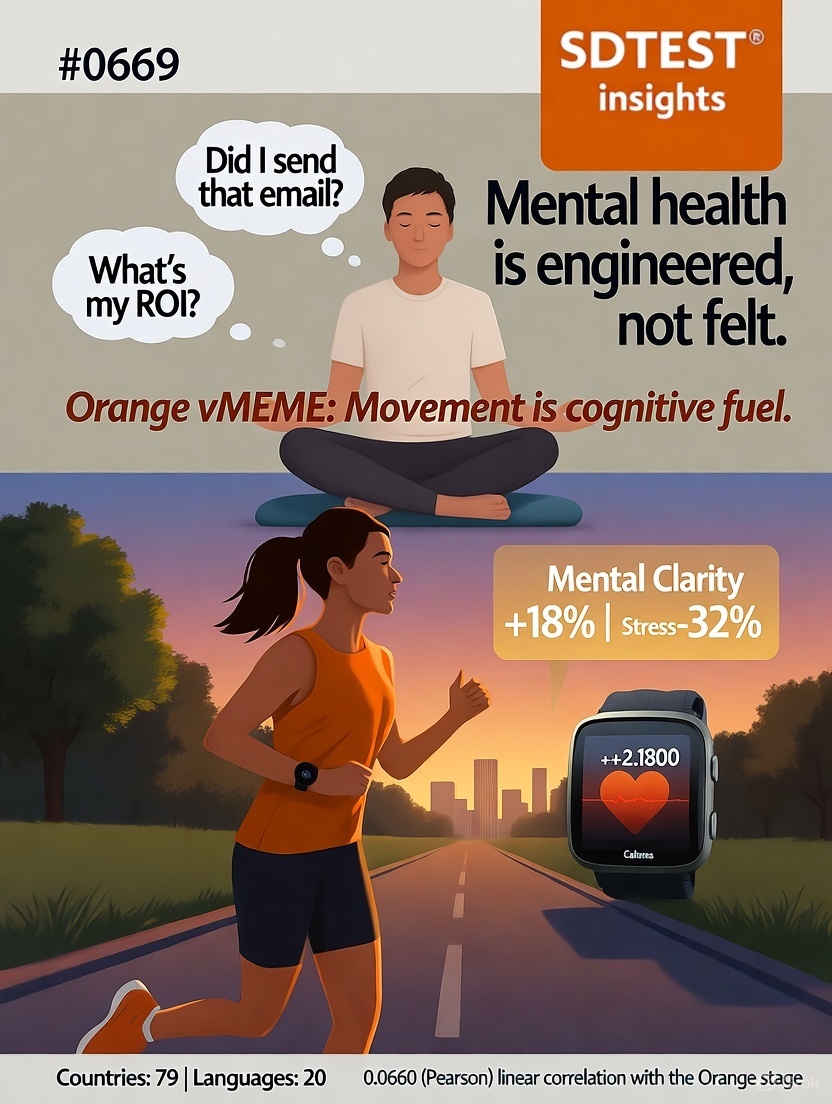
This positive correlation of 0.0660 between “Be physically active” as a mental-health tactic and the Orange stage offers intriguing insights when viewed through the lens of the Orange value system:
Organizational Perspective:
Organizations operating within the Orange mindset might interpret this correlation as:
- Validation that physical output is a measurable proxy for cognitive ROI, turning “well-being” into trackable KPIs (step-count, VO₂ max, HRV).
- Confirmation that subsidized gym memberships and wearable-data challenges boost productivity metrics more than intangible counseling budgets.
- Evidence supporting their belief that a fit body minimizes sick days and insurance premiums, quantifiable gains that please shareholders.
These organizations might respond by:
- Rolling out algorithmic wellness platforms that convert workouts into “mental-fitness credits” redeemable for bonuses.
- Installing leaderboard screens in lobbies ranking departments by average activity scores to gamify bio-data competition.
- Re-allocating EAP funds toward Peloton subscriptions because the regression line says motion > meditation.
Team Perspective:
Teams operating from an Orange mindset might approach this correlation by:
- Viewing it as proof that shared Strava challenges tighten focus faster than empathy circles; numbers don’t lie.
- Interpreting it as support for scheduling “data-driven sweat breaks” proven by studies to raise sprint-velocity by 7%.
- Seeing it as validation that sweat-generated endorphins are a biochemical hack for creative throughput, not a fluffy feel-good.
These teams might respond by:
- Replacing one stand-up per week with a 15-minute HIIT session logged into the project dashboard.
- Celebrating the member who hits 10k steps first with extra story-points: results speak, sentiment doesn’t.
- A/B testing code quality before vs. after treadmill desks to optimise the mental-output coefficient.
Individual Perspective:
Individuals aligned with the Orange value system might interpret this correlation as:
- Personal confirmation that miles run translate directly into neural efficiency, an equation they can graph.
- Evidence that time spent lifting is an investment with calculable cognitive interest, unlike “talk about feelings.”
- Proof that controlling the body’s variables is the fastest route to controlling performance variables, fulfilling self-reliance.
These individuals might respond by:
- Programming smart-watch alerts to enforce 85% max-HR zones because that range correlates with the highest post-workout creativity scores.
- Logging mood as a 1–10 Likert after every workout to build a private n=1 dataset for optimisation.
- Ignoring mindfulness apps, if it lacks a MET value, it’s noise, not signal.
This correlation, viewed through the Orange lens, suggests that those operating at the Orange level equate mental-health care with bodily output because both can be instrumented, optimised, and competitively benchmarked.
The reasons why “Be physically active” might be seen as the preferred mental-health intervention in the Orange stage could include:
- Quantifiable Metrics: Heart-rate, power-output, and step-count give objective feedback loops unattainable from abstract mood labels.
- Efficiency Maxim: A 20-minute run delivers endorphins and cardio benefit simultaneously; dual ROI on time invested.
- Technological Leverage: Wearables convert movement into big-data dashboards, satisfying Orange’s addiction to trackable progress.
- Competitive Edge: Activity leaderboards feed the achievement drive better than non-scored introspection.
- Scientific Backing: Peer-reviewed studies provide p-values linking exercise to cognitive enhancement; evidence beats sentiment.
This correlation prompts us to consider how different value systems influence perceptions of mental maintenance. It raises questions about the potential benefits and drawbacks of an Orange approach to psychological well-being, particularly in contexts where long-term collaboration and complex problem-solving are crucial.
Ultimately, this correlation highlights the complex interplay between cultural values, data-driven optimization, and organizational effectiveness. Physical activity might be seen not as mere exercise but as the most measurable, hackable input for cognitive output in Orange-dominant environments.
In our analysis of the poll "The Five Dysfunctions of a Team" (Patrick Lencioni [2]), we found an intriguing positive linear correlation that warrants closer examination:
0.1147 (Pearson) between the Absence of Trust (Without trust, teams cannot function at their optimum. Trust isn't just about believing in skills; it's about vulnerability-based trust) and the Green stage.
The critical value of the correlation coefficient for a normal distribution, by William Sealy Gosset (Student), is r = 0.1125. Nevertheless, this positive linear correlation of 0.1147 meets the reliability criteria but does not necessarily imply causation.
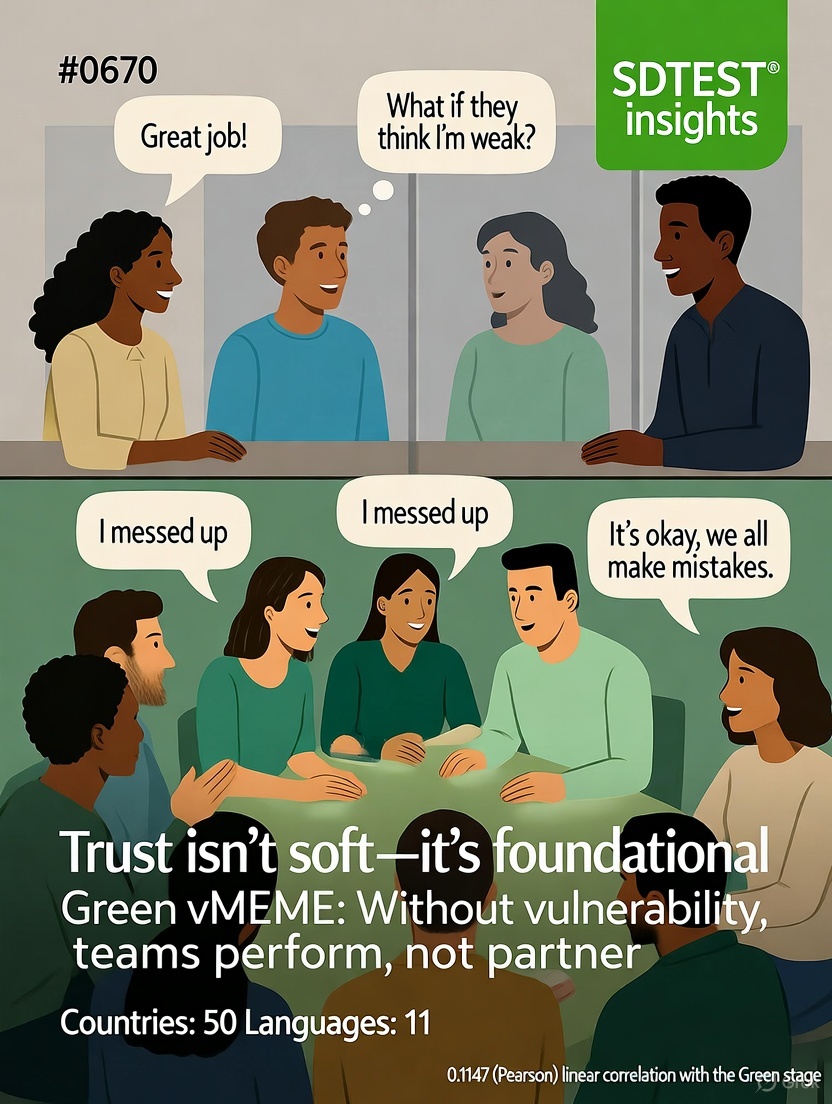
This positive correlation of 0.1147 between “Absence of Trust” and the Green stage offers intriguing insights when viewed through the lens of the Green value system:
Organizational Perspective:
Organizations operating within the Green mindset might interpret this correlation as:
- Validation that trust is the invisible lifeblood of a flat, consensus-rich ecosystem; without it, the whole living system wobbles.
- Confirmation that metrics, KPIs, and hierarchies can’t compensate for the felt vacuum of authentic human connection.
- Evidence supporting their belief that shared values alone don’t scale; psychological safety must be continuously cultivated like soil.
These organizations might respond by:
- Replacing quarterly profit reviews with “trust circles” where vulnerability metrics are tracked alongside carbon footprints.
- Installing anonymized “mood-bots” on Slack that feed trust-barometers into a real-time sustainability dashboard.
- Re-allocating budget from competitive bonuses to collective retreats focused on storytelling, empathy walks, and restorative practices.
Team Perspective:
Teams operating from a Green mindset might approach this correlation by:
- Viewing it as an organismic signal that unresolved micro-aggressions are poisoning the collective hive-mind.
- Interpreting it as proof that consensus without intimacy produces pseudo-agreement; harmonic on the surface, hollow beneath.
- Seeing it as validation that cooperative rituals (rotating facilitation, shared gratitude rounds) are not fluffy add-ons; they are essential nutrients.
These teams might respond by:
- Starting each stand-up with a two-minute “emotions weather-report” to surface distrust before it calcifies.
- Creating a rotating “trust guardian” role empowered to pause any decision when psychological safety dips below 7/10 on a quick pulse check.
- Celebrating the act of admitting uncertainty more loudly than delivering results, reinforcing that openness > output.
Individual Perspective:
Individuals aligned with the Green value system might interpret this correlation as:
- Personal confirmation that a trust-gap feels like spiritual oxygen deprivation; intellectually they’re included, somatically they’re alone.
- Evidence that their empathetic antennae are not oversensitive but finely tuned to the collective field.
- Confirmation that withholding true feelings to “keep the peace” paradoxically erodes the very harmony they cherish.
These individuals might respond by:
- Initiating weekly “check-in pairs” where dyads trade stories of fear and hope, feeding the trust fabric stitch by stitch.
- Using the correlation data as courage-fuel to name the elephant: “Metrics show trust is low, can we sit in a circle and feel what’s unsaid?”
- Choosing to stay vulnerable even when it hurts, believing that authentic rupture + repair deepens communal bonds more than polite silence.
This correlation, viewed through the Green lens, suggests that those operating at the Green level experience the absence of trust as a visceral void, a tear in the web of shared humanity that no amount of cooperative language can mask.
The reasons why an “Absence of Trust” might be felt as an especially painful dysfunction in the Green stage could include:
- Holistic Sensitivity: Green consciousness perceives the team as one living system; distrust registers like nerve pain throughout the organism.
- Equality Dependency: Flat power structures remove traditional scapegoats; without trust, every voice competes and harmony collapses.
- Eco-Analogue: Just as biodiversity needs mycorrhizal networks, diverse humans need relational glue; its absence feels like ecological collapse.
- Consensus Requirement: Decisions emerge through inclusive dialogue; mistrust stalls the process, creating chronic emotional friction.
- Shared-Value Authenticity: Green longs for heart-level unity; surface-level cooperation triggers cognitive dissonance that drains meaning.
This correlation prompts us to consider how different value systems influence perceptions of team health. It raises questions about the potential benefits and drawbacks of a Green approach to collaboration, particularly in contexts where rapid execution and competitive edge are crucial.
Ultimately, this correlation underscores the intricate interplay between cultural values, communal emotions, and organizational effectiveness. Trust might be seen not as a soft luxury but as the essential nutrient that keeps the collective ecosystem alive in Green-dominant environments.
0.0516 (Pearson) between the Empathetic and the Yellow stage.
The critical value of the correlation coefficient for a normal distribution, by William Sealy Gosset (Student), is r = 0.0366. Nevertheless, this positive linear correlation of 0.0516 meets the reliability criteria but does not necessarily imply causation.
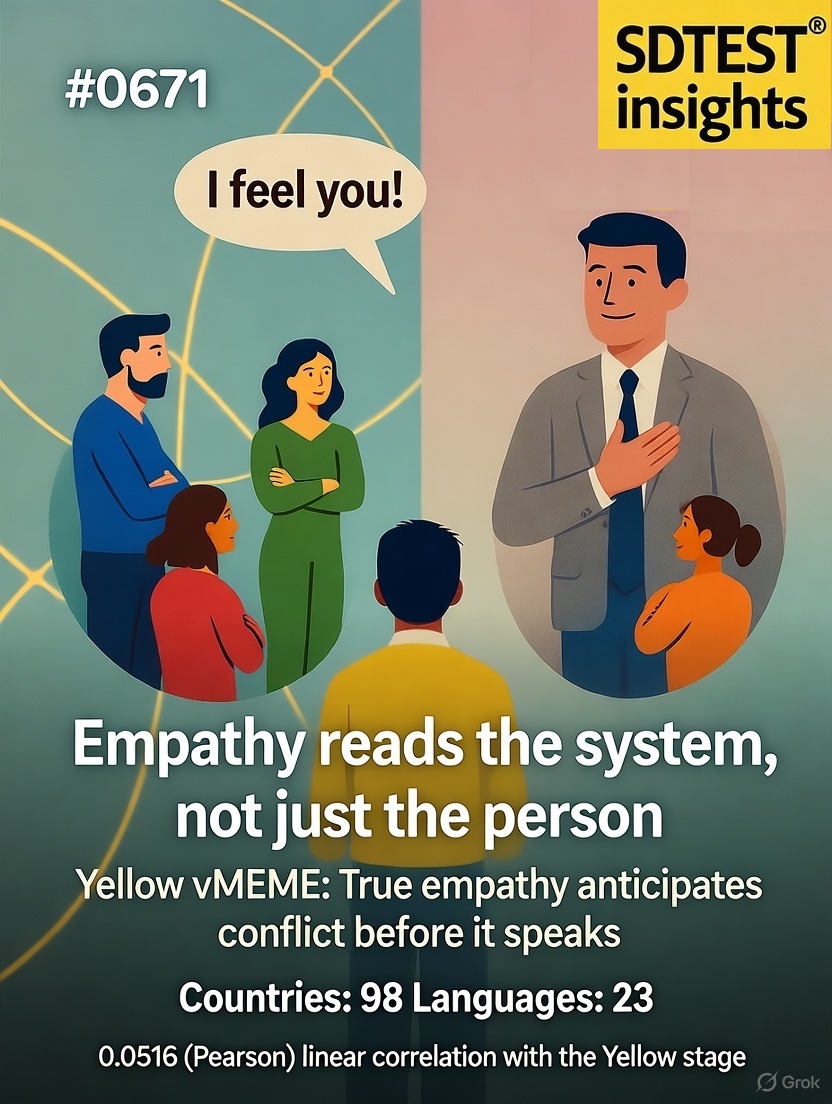
This positive correlation of 0.0516 between “Empathetic” and the Yellow stage offers intriguing insights when viewed through the lens of the Yellow value system:
Organizational Perspective:
Companies operating within the Yellow mindset interpret this correlation as:
- Confirmation that empathy functions as an adaptive intelligence layer, allowing the enterprise to sense, integrate, and respond to multi-level stakeholder feedback faster than any single-metrics dashboard.
- Validation that empathic data (mood, narrative, cultural nuance) is not “soft” but a critical input variable in complex-system optimisation.
- Evidence that transcending profit-only or people-only paradigms requires leaders who can hold both equations simultaneously; empathy is the integrative algorithm.
These companies might respond by:
- Embedding “empathy OKRs” alongside EBITDA, e.g., a 10% rise in peer-rated empathic accuracy must precede any new market expansion.
- Creating cross-paradigm councils where finance, ecology, and employee-story data are synthesised into weighted-decision models.
- Rewarding executives whose empathic interventions prevent downstream systemic drag, proving that care converts into complexity-cost savings.
Team Perspective:
Teams operating from a Yellow mindset approach this correlation by:
- Viewing empathic exchanges as distributed-processing nodes that shorten feedback loops across nested sub-systems (individual, dyad, squad, department).
- Interpreting it as proof that psychological safety is not a morale luxury but a prerequisite for the high-variety input Yellow teams need to map wicked problems.
- Seeing it as validation that empathic perspective-taking multiplies cognitive diversity without adding headcount; an elegant efficiency hack.
These teams might respond by:
- Running fortnightly “empathy retros” where each member presents a stakeholder POV they assimilated that sprint; insights are clustered into system-diagram walls.
- Rotating a “meta-positions” role: one person solely tracks emotional data-flow, ensuring no voice is lost while decisions scale.
- Celebrating instances where empathic sensing redirected a sprint, capturing the avoided cost in a shared knowledge graph.
Individual Perspective:
Individuals aligned with the Yellow value system interpret this correlation as:
- Personal confirmation that empathic attunement is a portable sense-making technology, expanding their cognitive bandwidth beyond personal expertise.
- Evidence that integrating body, emotion, mind, and context requires real-time calibration to others’ inner maps; empathy is the calibration tool.
- Proof that developmental stage growth is catalysed through relational feedback; empathic depth supplies the variety needed for self-transcendence.
These individuals might respond by:
- Practising “multi-perspective meditation” before key decisions; consciously cycling through Red power, Blue duty, Orange ROI, Green harmony to feel systemic tension.
- Logging empathic hits/misses in a personal complexity journal, treating misses as debugging data for their integrative algorithm.
- Using the 0.0516 figure as conversational leverage to advocate for empathic practices in dominantly Orange or Green spaces, meeting them with numbers they respect.
This correlation, viewed through the Yellow lens, suggests that those operating at Yellow do not see empathy as sentimental nicety but as an information-rich, complexity-reducing instrument that keeps the entire spiral healthy while it evolves.
The reasons why Empathy is viewed as essential for building successful teams in the Yellow stage could include:
- System-Feedback Loop: Empathy captures qualitative data streams that quantitative metrics miss, completing the sensing apparatus of a living system.
- Integration Catalyst: It bridges value-system conflicts (e.g., Blue order vs. Green equality) by translating each code into a language the other can feel.
- Cognitive Diversity Multiplier: Safe empathic fields encourage marginal voices to contribute, expanding the solution space for wicked problems.
- Developmental Accelerator: Relational mirroring supplies the perturbation individuals need to transcend their current complexity ceiling.
- Resilience Architecture: Empathic networks distribute stress laterally, preventing single-point failures that rigid hierarchies or pure markets cannot absorb.
This correlation prompts us to consider how different value systems influence perceptions of leadership competency. It raises questions about the potential benefits and drawbacks of a Yellow approach to empathic integration, particularly in contexts where rapid pivoting and multi-stakeholder governance are crucial.
Ultimately, this correlation highlights the complex interplay between cultural maturity, systemic sensing, and organizational effectiveness. Empathy might be seen not as a soft skill but as the keystone integrative technology that allows Yellow-enabled enterprises to thrive amidst volatility, ambiguity, and opportunity.
In our analysis of the poll "Factors that impact team effectiveness" (by Google), we found an intriguing negative linear correlation that warrants closer examination:
-0.0744 (Pearson) between the Dependability and the Turquoise stage.
The critical value of the correlation coefficient for a normal distribution, by William Sealy Gosset (Student), is r = 0.0534. Nevertheless, this negative linear correlation of -0.0744 meets the reliability criteria but does not necessarily imply causation.
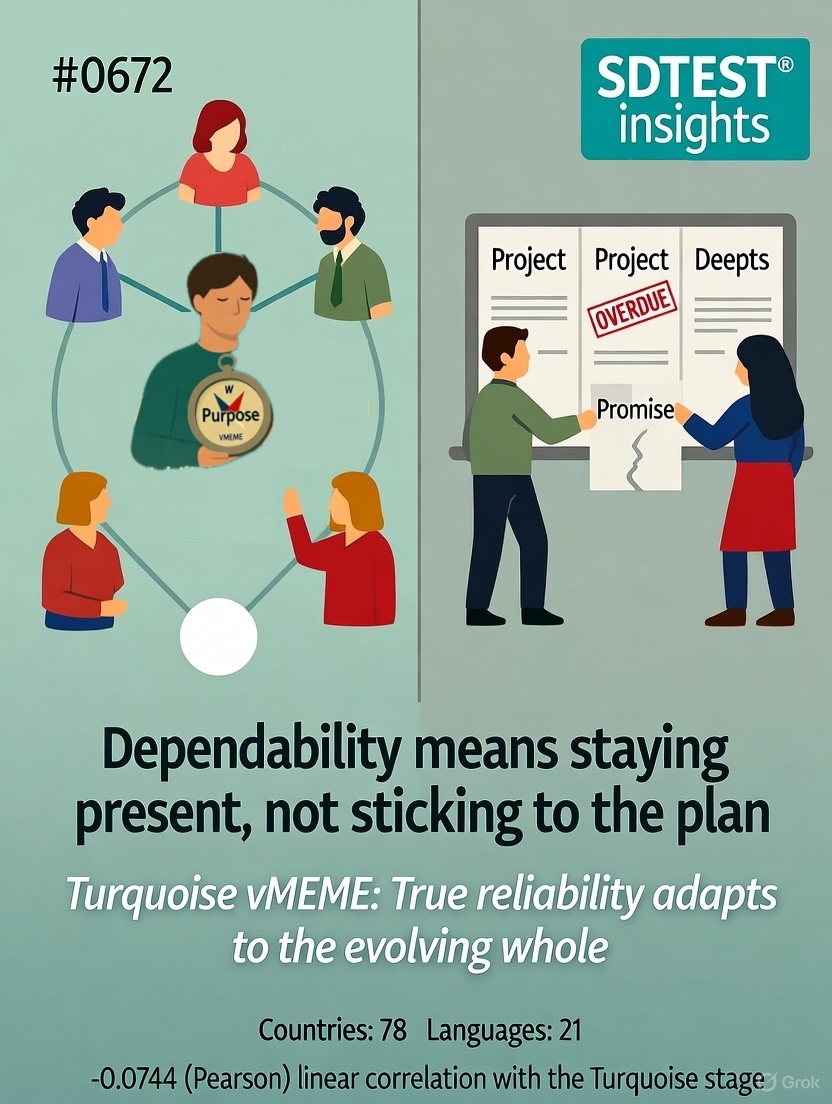
This negative correlation of –0.0744 between “Dependability” (individual predictability) and the Turquoise stage offers intriguing insights when viewed through the lens of the Turquoise value system:
Organizational Perspective:
Organizations aligned with the Turquoise value system interpret this correlation as:
- Validation that over-reliance on fixed roles or rigid delivery schedules fractures the living ecology of people-planet-profit they strive to harmonize.
- Confirmation that dependability metrics designed for machines undervalue the adaptive, soul-level creativity required for regenerative business.
- Evidence supporting their belief that true resilience emerges from self-organising flows rather than from guaranteeing the same output quarter after quarter.
These companies might respond by:
- Replacing “on-time delivery” KPIs with “systemic vitality indices” that track biodiversity restored, community joy levels, and carbon hand-print.
- Rotating accountabilities in fractal cycles, letting project leadership migrate to whoever senses the emerging need, like mycelium sharing nutrients.
- Celebrating employees who abandon timelines to follow planetary cues (solar-install days paused for bird migration) as guardians of holistic integrity.
Team Perspective:
Teams aligned with the Turquoise value system interpret this correlation as:
- Viewing it as proof that soulful synchronicity outperforms clockwork reliability when solving wicked, inter-linked challenges.
- Interpreting it as support for replacing “who owns what” with “what wants to emerge,” trusting collective intuition over individual pledges.
- Seeing it as validation that dependability can become ecological brittleness; predictable humans create predictable waste streams.
These teams might respond by:
- Opening meetings with silence to listen to the team field’s creative impulse before any agenda is honoured.
- Operating in dynamic role clouds printed on seed-paper that dissolve and re-print weekly, mirroring nature’s seasonal cycles.
- Praising members who miss deadlines to steward community grief after local floods, recognising this as the deeper deliverable.
Individual Perspective:
Individuals aligned with the Turquoise value system interpret this correlation as:
- Personal confirmation that their worth is measured by attunement to Gaia’s rhythms, not by calendar promises kept.
- Evidence that rigid dependability traps consciousness in ego-shells, whereas ecological responsiveness dissolves the self into the planetary Self.
- Proof that compassion sometimes reroutes them mid-task toward a stranger’s crisis, an act the data now blesses rather than blames.
These individuals might respond by:
- Sharing transparent “maybe lists” instead of commitment lists, inviting stakeholders into co-sensing what truly wants to happen.
- Practising “sacred re-negotiation ceremonies” where changed conditions are ritually acknowledged, freeing energy locked in guilt.
- Using the figure to reassure anxious partners: statistics confirm that less individual predictability can correlate with more systemic trust.
This correlation, viewed through the Turquoise lens, suggests that those operating at Turquoise equate excessive personal dependability with ecological fragility; they seek organisms, not mechanisms.
The reasons why Dependability might not be prized as a core team factor in the Turquoise stage could include:
- Eco-Fluidity: Fixed outputs ignore planetary feedback loops; responsiveness to Earth’s signals trumps human schedules.
- Trans-personal Priority: Consciousness is distributed across beings; clinging to one person’s reliability narrows the collective sensorium.
- Regenerative Diversity: Rotation of roles and timings increases biodiversity of ideas, mirroring resilient ecosystems.
- Sacred Emergence: Deadlines can override the subtle emergence that heals communities; unpredictability makes space for miracles.
- Compassion Over Contracts: Immediate care for sentient life (human or more-than-human) is honoured even if it disrupts prior promises.
This correlation prompts us to consider how different value systems influence perceptions of reliability. It raises questions about the potential benefits and drawbacks of a Turquoise approach to coordination, particularly in contexts where long-term survival of people-and-planet is crucial.
Ultimately, this correlation highlights the complex interplay between cultural depth, ecological responsiveness, and organisational vitality. Dependability might be seen not as a virtue but as an anthropocentric straitjacket that impedes the planet’s self-healing choreography in Turquoise-dominant environments.
What insights do you gain from today's correlation? How might we study this relationship more carefully before deducing causation?
We welcome respectful and wise perspectives! Stay tuned every week as we share more results and insights.
After login or registration, free access to the poll results in the FAQ section.
[1] www.linkedin.com/in/annavital
[2] www.linkedin.com/in/patrick-lencioni-orghealth
2025.11.02
FearpersonqualitiesprojectorganizationalstructureRACIresponsibilitymatrixCritical ChainProject Managementfocus factorJiraempathyleadersbossGermanyChinaPolicyUkraineRussiawarvolatilityuncertaintycomplexityambiguityVUCArelocatejobproblemcountryreasongive upobjectivekeyresultmathematicalpsychologyMBTIHR metricsstandardDEIcorrelationriskscoringmodelGame TheoryPrisoner's Dilemma
Valerii Kosenko
Produktposedanto SaaS SDTEST®
Valerii estis kvalifikita kiel socia pedagogo-psikologo en 1993 kaj poste aplikis sian scion en projektadministrado.
Valerii akiris magistron kaj la projekto- kaj programmanaĝertaŭgecon en 2013. Dum lia majstra programo, li iĝis konata kun Project Roadmap (GPM Deutsche Gesellschaft für Projektmanagement e. V.) kaj Spiral Dynamics.
Valerii estas la verkinto de esplorado de la necerteco de la V.U.C.A. koncepto uzante Spiral Dynamics kaj matematikan statistikon en psikologio, kaj 38 internaciajn balotenketojn.








